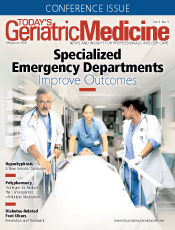
May/June 2016
Practical Solutions to Rural Elders' Health Outcomes Over the past few decades, rural elders have experienced worsening health care disparities. Factors contributing to this phenomenon include their isolation, both socially and geographically, poverty, and increased participation in high-risk behaviors. Rural communities, the states, and the federal government must begin to work together in a coordinated effort to combat this trend and improve the overall health and well-being of rural elderly communities. Utilization of Critical Access Hospitals, community transition programs, and rural health care services outreach programs are some of the efforts put forth by the federal government in coordination with local communities to improve health care access and thereby improve health outcomes among rural elders. With these readily available programs, rural elders can easily access the necessary health care. In 2015, the United States Census Bureau defined urbanized areas as those with 50,000 people or more and urban clusters as areas with 2,500 to 50,000. Any population or land falling outside of urban areas or urban clusters is consequently designated by the US Department of Health and Human Services as rural.1 In 2013, the older adult population in the United States was 44.7 million, accounting for 14.1% of the total American population.2 American elders, much like their younger counterparts, are ethnically and racially diverse, consisting of 78.8% white, 8.6% black, 7.5% Hispanic, 3.9% Asian/Pacific Islander, 0.5% Native American, 0.1% Native Hawaiian, and 0.7% who claim two or more races.2,3 In contrast to the overall US older adult population, 20% of the rural community is aged 65 and older.4 The higher representation of older adults in rural communities presents a unique set of challenges and requires strategic planning to halt the widening health care disparities noted in this population.5 The purpose of this article is to examine key factors that contribute to overall poorer health outcomes in the rural elder population and offer practical suggestions for overcoming widening health care disparities. Factors Contributing to Poor Health Outcomes Isolation In addition to social isolation, geographical distance both to health care providers and emergency services can significantly limit rural access to timely preventive care and chronic disease management and thereby worsen health outcomes.8 Rural elders too often encounter a noticeable lack of physical resources within their communities. Sadly, many rural elders find it difficult to access health care services in their local communities because of a lack of clinics or limited clinic hours and must therefore travel great distances to obtain basic health care services.8 Poverty High-Risk Health Behaviors Keys to Improving Outcomes Access to Inpatient Care In addition, the Affordable Care Act (ACA) provides for the creation of resource centers within rural communities to improve the elderly population's understanding of resources available to them through the federal government.12 Lastly, there are provisions within the ACA for the Community-Based Transition Program to improve follow-up of recently hospitalized elders with the intention of decreasing readmissions rates.12 Access to Outpatient Care Nursing is a vital component of improving the health of rural elders. Stuck et al conducted a randomized research trial involving extensive health risk assessments that were then evaluated by nurse counselors in an effort to develop each participant's personal preventive care model. Nursing personnel then provided extensive follow-up and education associated with each participant's care model. The researchers found that at two- and eight-year intervals, program participants had statistically improved health outcomes vs the control group.14 The research design relied heavily on the vital role nursing can and should play in risk assessment, education, and close community follow-up in an attempt to promulgate better health outcomes among rural elders.14 Local Efforts Final Thoughts — Mary Martin, MSN, RN, AGCNS-BC, ANCC, is the clinical site coordinator/clinical instructor at Martin Methodist College Nursing Division in Pulaski, Tennessee. With certification in adult-gerontology, she has had 24 years in the nursing profession, including experience in home health care and private duty nursing. — Julie Finch, MSN, RN, FNP-C, AGPCNP-C, AANPCP, a hospitalist at Marshall Medical Center in Lewisburg, Tennessee, is currently seeking her doctorate of nursing practice at the University of Alabama-Huntsville. She has worked in the field of nursing for more than 25 years in all regions of the United States. References 2. Administration for Community Living Administration on Aging. A profile of older Americans: 2014. http://www.aoa.gov/Aging_Statistics/Profile/2014/docs/2014-Profile.pdf. Accessed September 17, 2015. 3. Ortman JM, Velkoff VA, Hogan H; US Census Bureau. An aging nation: the older population in the United States. https://www.census.gov/prod/2014pubs/p25-1140.pdf. Published May 2014. Accessed October 28, 2015. 4. What's different about rural health care? National Rural Health Association website. http://www.ruralhealthweb.org/go/left/about-rural-health/what-s-different-about-rural-health-care. Accessed September 17, 2015. 5. Singh GK, Siahpush M. Widening rural-urban disparities in life expectancy, U.S., 1969-2009. Am J Prev Med. 2014;46(2):e19-e29. 6. Morken L, Warner M. Planning for the aging population: rural responses to the challenge. National Association of Area Agencies on Aging. http://s3.amazonaws.com/mildredwarner.org/attachments/ 7. Dury R. Social isolation and loneliness in the elderly: an exploration of some of the issues. Br J Community Nurs. 2014;19(3):125-128. 8. Douthit N, Kiv S, Dwolatzky T, Biswas S. Exposing some important barriers to health care access in the rural USA. Public Health. 2015;129(6):611-620. 9. DeNavas-Walt C, Proctor BD; US Census Bureau. Income and poverty in the United States: 2013. http://www.census.gov/content/dam/Census/library/publications/2014/demo/p60-249.pdf. Published September 2014. Accessed October 28, 2015. 10. Medicare 2016 costs at a glance. Medicare.gov website. https://www.medicare.gov/your-medicare-costs/costs-at-a-glance/costs-at-glance.html. Accessed October 29, 2015. 11. US Department of Health and Human Services, Centers for Medicare & Medicaid Services. Critical access hospital. https://www.cms.gov/Outreach-and-Education/Medicare-Learning-Network-MLN/MLNProducts/downloads/critaccesshospfctsht.pdf. Updated February 2016. Accessed October 29, 2015. 12. Agency for Healthcare Research and Quality. 2014 National Healthcare Quality & Disparities Report. http://www.ahrq.gov/sites/default/files/wysiwyg/research/findings/nhqrdr/nhqdr14/ 13. Morris T. Aging in rural America: preserving seniors' access to healthcare. Health and Human Services website. http://www.hhs.gov/asl/testify/2008/07/t20080731f.html. Updated June 18, 2013. Accessed September 17, 2015. 14. Stuck AE, Moser A, Morf U, et al. Effect of health risk assessment and counselling on health behaviour and survival in older people: a pragmatic randomised trial. PLoS Med. 2015;12(10):e1001889. |
